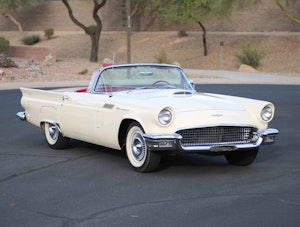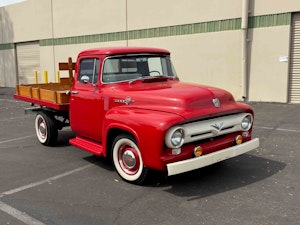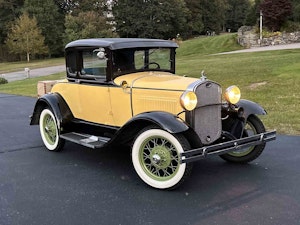Media | Articles
Since the ’60s, Ford Has Stored Cars Underground in a Kansas City Cave
You may have seen a photo floating around the Internet that depicts a gaggle of Mavericks—not the pickup, but the econo-coupe that preceded it—lurking in what appears to be some type of natural cave. Dig a little deeper, and you might even stumble across a sentence or two explaining that these unlikely spelunkers represent overstock stuffed by Ford into a subterranean system carved deep beneath the bedrock of Missouri.
The image might seem an oddball anachronism, some kind of temporary solution to overflowing dealer lots that somehow made sense in the 1970s. Would it surprise you to find out that Ford is actually entering its seventh decade of keeping cars in said caves, which are part of a vast business complex called SubTropolis?
Legacy of Limestone
Most of the time, defunct mining operations are viewed as hazards and liabilities. The legacy of resource extraction is highly variable but almost always negative, except in those rare cases where geology and foresight converge to present a singular opportunity.

Such was the case with the Bethany Falls limestone mine, a 1940s operation that dug deep into the 270 million-year-old bedrock underpinning Kansas City, Missouri. In the process, miners procured much of the stone that was used to construct the buildings and infrastructure needed for the bustling metropolis sprouting up in the center of America. Although limestone exports were strong throughout the 1940s, over the course of the following two decades it began to look like the economic potential of the mine had been fully wrung from the rock. Left behind was a unique complex of stable, moisture-free man-made caverns located within Kansas City limits. Two decades later, it took an outsider to recognize the commercial potential of the mine’s skeletal remains.
“The Hunt family got involved when Lamar moved up from Texas and brought the Kansas City Chiefs with him [in 1963],” said Ryan Tompkins, Director of Sales and Leasing at SubTropolis. “He wanted to invest in Kansas City and really show its people that he was here for good. He wanted to put his roots out. So he purchased the active limestone mine at that time.”
Marketplace
Buy and sell classics with confidence
It’s here that SubTropolis began to take shape. Rather than continuing to run the facility exclusively as a mine, Hunt began to use it to store mining equipment as well. It was a solid proof of concept: With a depth of up to 160 feet, the temperature inside the network of tunnels and chambers hovers between 68 and 72 degrees all year round, with humidity sitting at a comfortable 40 percent. Thanks to the miners’ use of an extraction technique called the “room and pillar method,” the enormous underground cavities left behind are supported by 16-foot pillars; the space is open, regular, and, expansive enough to accommodate nearly anything that can fit through its above-ground, drive-in entrance ramps.
Ford Tags In Early

It didn’t take long before SubTropolis attracted its first major client. An article from the Ford Kansas City News employee newsletter dated August 30, 1965, features the headline “Parts Storage Area Completed After 560,000,000 Years,” and describes the company’s plans to use 82,000 square feet of the SubTropolis facility to support its nearby Kansas City Assembly Plant, which was originally built in 1951. Another article written a month later describes something called the “Ford Family Showing” that welcomed 5000 people into the limestone caves so they could get a look at automaker’s 1966 line-up.
“In Kansas, in the Midwest, you get rain, you get hail, you get winter, you get ice, you get everything. And I think [Ford] really wanted to store the vehicles that they were producing and assembling in the area that wouldn’t come into harm’s way,” said Tompkins. “And so what better location than under a large roof? Since then, Ford has relocated its plant and they are now really adjacent to our underground, so we continue to have a really tight relationship with them.”
Blue Oval In The Bedrock

Although Hunt Midwest works with other automotive partners at SubTropolis, Ford is truly the anchor tenant. With its Kansas City plant still building the F-150 pickup (as it has since 1957), and another nearby Missouri facility churning out the Transit van, the company’s underground presence has grown alongside both of those product lines.
“It’s really Automotive Alley,” said Tompkins, referring to the business center built above the caves. “You can consider SubTropolis as the ‘basement’ to the surface property and buildings up top. In addition to its production facilities, Ford has located its North American Vehicle Logistics facility, called the NAVL facility, right beside us.”

What this means, functionally, is that every Transit produced in the United States since 2014 passes through Kansas City. This lure, plus the presence of the evergreen sales monster that is the F-Series, has attracted a critical mass of aftermarket upfitters—companies that modify vans and trucks for various commercial or retail buyers—that have chosen to locate their businesses within the confines of the cave complex.
“Since NAVL arrived, we’ve added close to two dozen upfitters occupying close to a million square feet. That’s up to 120 acres of vehicle logistics, [which] equates to 13,000 vehicles [in SubTropolis] at any given time,” said Tompkins.
That footprint is on top of the 2 million square feet provided by surface buildings. The 7.8 million of available square footage located underground is served by a stunning 10 miles of roads. Those figures are subject to change, as SubTropolis is constantly expanding, and Hunt Midwest claims 55 million square feet of usable space would be available in total should the entire cave system be developed.

The appeal of being close to Ford’s infrastructure is only part what’s led to SubTropolis’ success as a haven for truck and van customization. Kansas City has the advantage of proximity; it is located within a two-day drive of 90 percent of the population of the continental U.S., greatly simplifying transportation and planning for operations. Then there’s the fact that snowy winters, rainy springs, and blistering summer heat have no impact on underground workers, who are free to comfortably install bedliners or transform a panel van without ever needing to surface. And don’t forget, it’s hard to beat the security of surrounding your business with impenetrable limestone.
Stalactite Drift

SubTropolis claims to be the largest underground business facility ever built. By extension, that makes Ford’s operations there the largest subterranean automotive operation. With the vast majority of the action hidden from prying eyes, perhaps it’s to be expected that most enthusiasts are unfamiliar with the fact that the Blue Oval has been digging into the Missouri bedrock for 70 years. You don’t have to be a Bond villain to appreciate the privacy, convenience, and stability of the caves, but it wouldn’t be at all surprising to see something like SubTropolis show up as the backdrop for a chase sequence in the next Fast and Furious installment, with Torreto and fam drifting Raptors around 25 square-foot limestone pillars that are as cinematic as they are crucial to supporting an automotive operation like no other.


















In May of 1964, I toured the space and saw the new Mustangs on display.
Used to pick up loads of frozen meat from cold storage businesses in the caves. Drove semi about half mile back into the cave. Kind of creepy
I have driven my 18 wheeler deep down inside of this mine; It was kind of strange & slightly dusty; No way could I work a shift with no windows or doors available; Was weird to see office staff working behind glass store fronts way underground…
Good stories i like Studebakers 19551953 1954 1961 Hawk + Irebuilt 1925 ts @age 16 17 now 93 11271931 ben there did some
Did they pour concrete for the floor or grind down the limestone in Subtropolis?
Crappy writing makes for a crappy story. Nice job